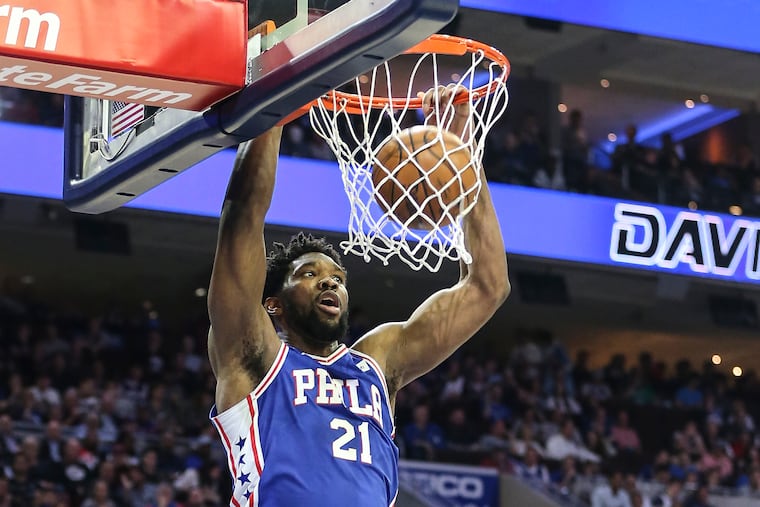Sixers schedule is out, so let’s try to envision Joel Embiid’s workload | David Murphy
Keeping their star center healthy will be the Sixers' top priority this season. Here's a look at how they can do it.

As a theoretical exercise, managing Joel Embiid’s workload is not a complex thing. In fact, its simplicity is the primary source of the exasperation that Sixers fans have felt in each of the last two seasons when the first few bars of the same old song and dance began to play.
Last February, Embiid was days removed from participating in the NBA All-Star Game when news broke that he would miss at least a week with a bout of knee soreness. In 2017-18, he was coming off a game in which he logged 48 minutes of court time in a triple-overtime loss to the Thunder. In both instances, the general reaction regarded the injuries as eminently preventable, given the excessive number of minutes that had preceded them.
But like a lot of things in this world, what seems simple in theory gets a lot more complicated once reality arrives. It might seem like a no-brainer to limit Embiid’s minutes during the regular season, but doing so requires a tremendous amount of discipline and delayed gratification, two things that often come into conflict with the expectations of a demanding fan base and media market.
Now that the NBA schedule has been released, we have a better idea of how this tension of opposites will manifest itself over the course of the season.
General manager Elton Brand sounds determined to avoid a repeat of last season, when Embiid entered the postseason with an ailing knee and a level of conditioning that left him as a shadow of himself on the offensive end of the court. Once it became clear to the Sixers that Jimmy Butler wasn’t going to be a part of their long-term plans, Brand started laying the groundwork for one of the more daring pivots of the NBA offseason, with the goal of building a team that would maximize its chances of arriving at next year’s playoffs with a healthy Embiid as the team’s undisputed bell cow.
In addition to signing veteran big man Al Horford to a four-year, $109 million contract, he persuaded gritty journeyman Kyle O’Quinn to sign for the veteran minimum.
As a result, coach Brett Brown now has two legitimate options to offload some of Embiid’s minutes at center without suffering the precipitous decline in production that has plagued the Sixers the last two seasons. He also has a dramatically upgraded defense in front of Embiid thanks to the acquisition of Josh Richardson, who effectively replaces J.J. Redick as a perimeter defender.
With the start of the 2019-20 season two months away, the hope is that the Sixers will be able to manage Embiid’s workload in a way that was not possible in seasons past. Not only does that mean carefully monitoring his minutes on a nightly basis but also avoiding the temptation of playing him on back-to-back nights.
“Whatever it takes,” Brand said at his most recent news conference. “Having these options, we did fall off a cliff once Joel was off the court, especially defensively, so having these great options now bodes well for our team success. And he’s on board, for sure.”
In theory, the Sixers have the personnel to manage the loads of both Embiid and Horford in a manner similar to the way the Celtics did with Horford last season.
The 33-year-old center averaged a career-low 29 minutes per game for Boston last season and played in just 68 of 82 regular season games. That might seem a bit conservative for Embiid, who averaged 34 minutes per night and played in both ends of all seven back-to-backs on the Sixers’ schedule before his February layoff. But, then, that layoff is the point.
Consider the first-half rotation in the tables below, which are based loosely on Brown’s substitution patterns over the last couple of seasons. In such a world, either Embiid or Horford would be on the court for 30 of a game’s 48 minutes, and on the court together for 15 of those minutes
First quarter
Second quarter
No doubt, asking for 18 minutes per night out of Kyle O’Quinn is counterintuitive for a team that has so much money invested in its top two big men. But O’Quinn isn’t your typical third-line center. He’s averaged at least 15 minutes in four of his seven NBA seasons, including 18 minutes per night in 2017-18, albeit with the Knicks. Plus, remember the goal here: keep Embiid fresh.
The biggest variable in this quest might be the usage of Embiid and Horford on back-to-back nights. In Boston last year, Horford played both ends of a back-to-back seven times, by my count.
Of the Sixers’ 13 back-to-back games, only four feature a pair of opponents that will enter the season as legitimate playoff contenders: Spurs/Heat at home in late November, Celtics/Pelicans in a road/home two-fer in mid December, Magic/Heat in a pair of road games in late December, and Spurs/Pelicans in a pair of road games in April. The rest feature teams that could be among the worst in the NBA: Cleveland, New York, Cleveland, Washington, New York, Memphis, Cleveland and New York, Charlotte, Phoenix.
If the Sixers can limit Embiid to, at most, four back-to-backs, that will be a far more aggressive load management approach than they deployed last season.
Limiting his minutes on a nightly basis will require a greater level of restraint. But given what we’ve seen the last couple of seasons, and the roster that Brown now has at his disposal, the long-term benefits of an ounce of prevention could prove well worth its short-term cost.